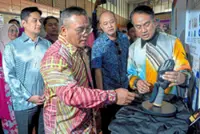Jobseekers at one of Socso’s weekly open job interviews held nationwide recently. As at August this year, 745,100 people who make up 4.7% of the country’s labour market remain unemployed.
THE Covid-19 pandemic and the associated economic crisis are posing huge challenges at levels that the world has not seen since the Great Depression in the 1930s.
More worryingly for Malaysia, this crisis will test our resolve as it is an even greater task than that faced during the Asian Financial Crisis in 1998.
According to statistics obtained from the International Monetary Fund (IMF) and International Labour Organisation (ILO), Covid-19 will likely result in -4.90% global GDP contraction, with over 435 million businesses disrupted due to global lockdowns, and a projected loss of 305 million jobs in the formal sector as well as putting an additional 1.6 billion informal workers at risk.
The IMF’s latest World Economic Outlook was aptly titled. This is a crisis like no other with an uncertain recovery.
At the heart of the rakyat’s concerns is jobs. Job creation in Malaysia remains too weak to reduce unemployment significantly.
Unemployment
Despite economic reopening and multiple rounds of stimulus packages via Bantuan Prihatin Nasional and Pelan Jana Semula Ekonomi Negara (Penjana), the fact of the matter is, over 745,100 individuals remain unemployed as of August 2020.
To put this into perspective, this is 4.7% of our labour market, far above Malaysia’s historical natural rate of unemployment at 3+%.
As the labour market remains uncertain, this causes grief and worry among Malaysians which will not abate.
Will they be able to hold on to their existing jobs? For those who have been furloughed or let go, how long before the next opportunity comes by?
This is a slippery slope. If a jobseeker remains unemployed for longer periods of time, this may lead them to drop out of the labour market altogether.
Furthermore, this crisis will only exacerbate the structural labour issues that have already plagued Malaysia before Covid-19. This includes:
High youth unemployment and underemployment: 40% of youth are unemployed and 60% of youth are working outside of their field of expertise.
Low women participation rate: There are only 54% of women in the labour force, with many opting to drop out around the age of 30.
In times like these, policymakers must play a role to not only address the lack of demand for jobs but also implement measures to address this mismatch in the market.
This is where labour market initiatives come into play.
Labour market initiatives are policies that facilitate full or productive employment through Active Labour Market Policies (ALMPs), labour exchanges and market demands.
ALMPs can enhance the efficiency of labour markets. They improve information and coordination, support and encourage training and retraining, help firms to find the right talent faster, fill in open vacancies more rapidly, and play a significant role in strengthening the nation’s economic recovery.
To ensure an effective labour market policy, it must be guided by three pillars:
1. Strong public-private partnerships.
2. Upgrading and reskilling including vocational and entrepreneurship programmes.
3. Buttressed by an effective and coordinated employment service.
While Malaysia already has several labour market initiatives, the emphasis now is on Pillar 3 whereby the country must strengthen its coordination.
In doing so, we can learn from other countries that have already deployed labour market policies that are supported with coordinated employment services:
Australia: Job Services Australia, under the Department of Education, Skills and Unemployment, serves the Australian government’s employment services programme that supports job seekers and employers. Under this initiative, they provide tailor-made support to help job seekers find jobs and help employers fulfill their employment needs.
Denmark: The Danish Agency for Labour Market and Recruitment plays a central role in the implementation of reforms and employment policies by supporting municipalities and unemployment insurance funds. Under this framework, the agency coordinates with unemployment insurance funds and assist in direct implementation of reforms and labour market policies.
Singapore: Coordination between SkillsFuture and Workforce Singapore helps drive national efforts to help Singaporeans develop skills relevant to the future and build the right talent for these jobs. This programme has made them pioneers for future-looking labour market initiatives as they assist Singaporeans to secure quality jobs at different stages of life.
Malaysia’s current state
Looking closer to home, coordination in Malaysia remains fragmented.
Today, we have many job portals coordinated by various ministries. With each agency or ministry working in silo on their placement exercises and job fair activities, this fragmentation provides administrative burdens to the Government, employers and prospective employees as they struggle to identify the most relevant programmes and services available.
Furthermore, from a policy perspective, this fragmentation complicates demand and supply analysis which can hinder enhancements for future programmes.
In order to make it easier for the rakyat to access these services, I am in support of the establishment of an integrated national employment service that can provide a one-stop centre for employers and prospective employees, programmes that facilitate entry and reentry into the job market, as well as access to social services.
The existence of this national employment service can serve multiple benefits.
For employees and employers, they now have a single portal whereby they can acquire full information on services and programmes available.
For the Human Resources Ministry, this will help in effective and agile funding to finance programmes that are most relevant.
Lastly, for practitioners and policymakers, a national employment platform will allow us to garner homogenous data that can be accessed by ministries, agencies and academia to help shape future labour market initiatives.
This national employment service can be led by the Social Security Organisation (Socso) given their recent involvement in the Prihatin and Penjana programmes.
On a final note, we should remain cognizant of the issues at hand. Ultimately, just because we are doing a lot, it does not mean we are getting a lot done. We should not confuse movement with progress.
Having multiple labour market programmes and portals without coordination will only prolong Malaysia’s unemployment issues.
It is now time for us to regroup, refocus, and reorganise Malaysia’s labour market programmes to help expedite this recovery.
Datuk Dr Norma Mansor is president of the Malaysian Economic Association and emeritus professor and director, Social Wellbeing Research Centre, Universiti Malaya.





